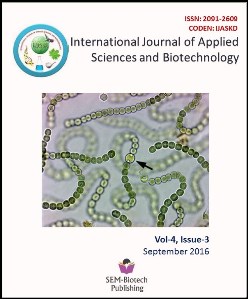Performance of Broilers Fed Diets Supplemented With Graded Levels of Soybean Oil and Different Sources of Bone Meal
DOI:
https://doi.org/10.3126/ijasbt.v4i3.15424Keywords:
Soybean meal, Bone meal, GBM, PBM, IBM, Broilers, PerformanceAbstract
An experiment was conducted to investigate the effects of inclusion of three levels of soybean oil (0%, 2% and 4%) and three sources of commercial bone meals (GBM, PBM and IBM) in the diet of broiler chicken. Body weight, weight gain, feed consumption, feed efficiency, digestibility coefficient, calcium, phosphorus and ash content of blood and bone of broilers were measured. Significantly higher (P<0.01) average weekly feed consumption, average cumulative body weight, average weekly body weight gain was found in broilers fed diets containing soybean oil. The highest (5058.27 g) average total feed consumption was recorded on T9 and the lowest (4117.88 g) on T1. The highest average cumulative body weight was obtained on T6 (2168.33 g) and was the lowest on T1 (1930.00 g). Similarly, the highest average body weight gain was recorded on T6 (301.04 g) and the lowest on T1 (273.77 g). The abdominal fat weight percentage was maximum (2.38%) on the diet containing 4% soybean oil with GBM and minimum (1.04%) on the diet without soybean oil withIBM. However, the overall performance of broilers was found improved on the diet containing soybean oil. The ash, calcium and phosphorus content of blood and bone were better when supplied the diet with 2% to 4% soybean oil containing the sources of bone meal. Considering better bone calcification, phosphorus and minerals utilization in the chicken body, 2% to 4% levels of the soybean oil with the GBM source of bone meal could be incorporated in the diets.
Int J Appl Sci Biotechnol, Vol 4(3): 272-280




